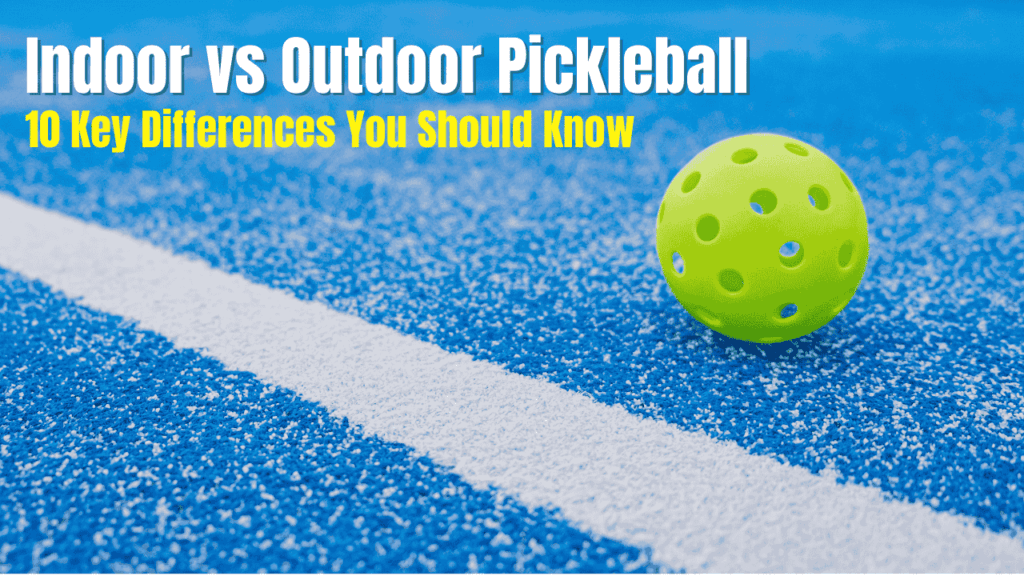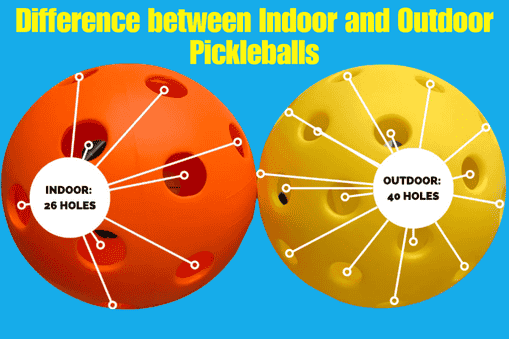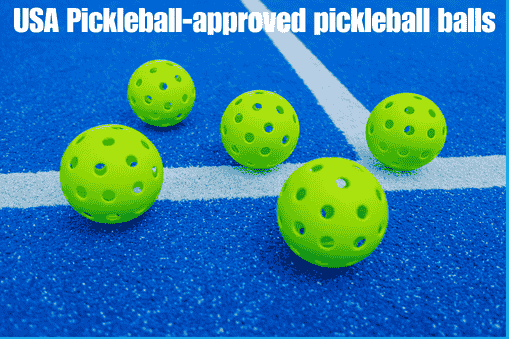No products in the cart.
Indoor vs Outdoor Pickleball: 8 Key Differences You Should Know
When it comes to choosing the right pickleball for your game, understanding the difference between indoor and outdoor options is crucial. The performance of the ball can drastically impact your playing experience, depending on whether you’re enjoying a game indoors or out.

Indoor balls are typically designed to be lighter and bounce higher, making them ideal for controlled environments like courts with consistent flooring.
In contrast, outdoor balls are heavier, designed to withstand wind and environmental factors, offering a more durable and reliable choice for outdoor games.
Whether you are a beginner or an experienced level player, knowing how these factors affect your game can help you choose the right ball for the challenges ahead.
Indoor Pickleball vs Outdoor Pickleballs
Indoor balls have 26 larger holes for a higher bounce, while outdoor balls with 40 smaller holes are heavier and more durable for climate and surface challenges. The choice affects weight, texture, and hardness, influencing control and performance. Typically, use the indoor ball for smooth courts and the outdoor ball for tougher conditions.
As someone who has spent a fair amount of time playing both indoors and outdoors, I have personally noticed how much spin, reaction, and control differ between the two.
The surface and air conditions of outdoor courts, along with the material and texture of the balls, really influence strategy and skill in the game.
When you are playing outdoors, you have to account for wind and the environment, while indoors, it’s all about speed, accuracy, and consistency.
Difference between Indoor and Outdoor Pickleballs.
When it comes to pickleballs, the differences between indoor and outdoor versions are more noticeable once you handle them or see them side by side.

While they may look similar at first glance, here are 8 key differences:
- Number of Holes:Indoor balls have 26 holes; outdoor balls have 40 for better wind resistance.
- Hole Diameter: Indoor balls have wider holes, outdoor balls have smaller ones.
- Weight: Outdoor balls are heavier, offering more stability in wind.
- Hardness: Outdoor balls are harder for better bounce on rough surfaces.
- Durability: Outdoor balls crack more easily, indoor balls are softer and last longer.
- Surface Texture: Indoor balls are smooth, outdoor balls are textured for wind resistance.
- Bounce Height: Indoor balls bounce higher; outdoor balls bounce lower for control.
- Material Composition: Indoor balls are softer; outdoor balls are made of tougher plastic.
These differences are important to note when choosing the right pickleball for your game, whether indoors or outdoors.
1. Number of Holes
When comparing indoor and outdoor pickleballs, one of the first noticeable differences is the number of holes. Indoor balls typically have 26 wider holes, while their outdoor counterparts feature 40 smaller, more closely-packed holes.
Why does this matter? It’s all about staying true to your shots, and the holes help to neutralize the effects of external factors, such as wind or the surface of the court. The robustness offered by these numerous smaller holes on the outdoor ball makes it more suitable for windy conditions.
Not only do the holes improve aerodynamics, but they also ensure a more consistent and accurate flight trajectory. Each hole is carefully beveled into the plastic, designed for a uniform size and placement, providing a reliable bounce.
In some outdoor pickleballs, you might even notice two different hole sizes, but regardless of that, the aerodynamics are optimized for the harsh conditions of outdoor play.
2. Hole Diameter
When it comes to the diameter of holes in indoor and outdoor pickleballs, there is a notable difference. Indoor balls have wider holes, usually measuring about .43-inches, while outdoor balls feature smaller holes, measuring approximately .282-inches.
This makes the hole diameter on indoor balls 40% larger than that of outdoor pickleballs, which significantly impacts their flight and bounce.
The reason for this variation lies in the need to optimize performance: indoor balls with their larger holes are designed to handle less wind and provide a more consistent trajectory.
On the other hand, the smaller, closely-packed holes in outdoor pickleballs make them better equipped to withstand windy conditions and offer improved robustness during play.
This difference in hole diameter is crucial for understanding how each ball performs across different environments, and it’s not just theoretical this data comes from measuring common models available on the market today.
3. Weight
When it comes to weight, it’s well known that outdoor pickleballs weigh slightly more than indoor balls. But the difference is not as huge as many might assume. The holes on the balls play a significant role in this.
While indoor pickleballs have fewer holes (26 compared to 40 in outdoor balls), the diameter of the holes in indoor pickleballs is about 40% greater, covering more surface area. This results in more negative space, making the indoor balls lighter.
The reason why outdoor pickleballs are heavier also has to do with external conditions, like wind interference. The added weight helps keep the ball more stable and true to its intended course during play, especially on windy days.
While the weight difference between the two is quite nominal, at less than 1%, it’s interesting to note that outdoor balls average about .925 ounces compared to .917 ounces for indoor balls.
Interestingly, there was more variance in the weight of outdoor balls, with the lightest weighing only .897 ounces.
4. Hardness
When it comes to the hardness of a pickleball, not all plastics are created equal, and brands often use different materials to achieve varying levels of performance.
The hardness of these balls is usually measured using the durometer hardness test, which grades materials based on Shore D values, with 100 being the hardest. Different plastics and rubbers fall
- LDPE – Low-Density Polyethylene: 40-50
- HDPE – High-Density Polyethylene: 60-70
- PP – Polypropylene: 70-83
- PET – Polyethylene Terephthalate: 85-95
on a scale between 0 to 100, indicating how hard or soft they are. For instance, TPE (thermoplastic rubber) is much spongier than HDPE, which is typically used in outdoor balls.
This variation in hardness directly influences a ball’s performance, affecting its bounce and compression.
Whether you’re playing indoors or outdoors, the choice of material plays a significant role in how the ball reacts during gameplay.
5. Durability
It’s a common belief among beginners that pickleballs will last a lifetime, but the truth is, both indoor and outdoor balls lose their shape over time.
Whether it’s the hard nature of an outdoor ball or the temperature changes, constant use will eventually cause the ball to start cracking. Durability is significantly influenced by the materials and construction of each ball.
Typically, the harder the material carbon fiber paddle, the more likely it is to have a shorter lifespan. For instance, TPE is known for its high elastic properties, making it much more difficult to crack or lose its shape compared to harder plastics, which tend to crack easily, often with minimal stress.
6. Surface Texture
Indoor pickleballs generally have a smoother surface, while outdoor pickleballs are more textured. The textured surface on outdoor balls helps them resist wind and provides more control when playing outside, where the elements come into play.
This makes outdoor pickleballs ideal for maintaining consistency in flight despite changing weather conditions.
7. Bounce Height
Indoor pickleballs tend to bounce higher due to their softer construction. This allows for a faster game and more aggressive pickleball play.
Outdoor pickleballs, with their heavier and tougher build, tend to have a lower bounce, which helps control the ball’s movement in open spaces and provides a better response to outdoor conditions like wind or uneven surfaces.
8. Material Composition
While both types of pickleballs are made from durable plastic, indoor balls are typically made from softer plastic, making them less resistant to wear.
Outdoor balls are usually crafted from harder plastic that can withstand rougher playing surfaces, including concrete or asphalt courts. This tougher material helps the ball endure longer outdoor use.
USA Pickleball-approved pickleball balls

USA Pickleball is the governing body responsible for establishing the official standards for pickleball balls used in play. Below are their official rules for pickleballs.
2.D.1 Construction
The ball should be crafted from a durable material with a smooth surface, free of any texturing, and have a uniform color, except for necessary identification markings.
Additionally, it may have a slight ridge at the seam, but only if it doesn’t noticeably affect the ball’s flight characteristics.
2.D.2 Approval (for official tournaments only)
The Tournament Director is responsible for selecting the pickleball tournament ball.
The ball used in any USA Pickleball or Global Pickleball Federation (GPF)-sanctioned tournament must be listed on the official list of approved balls available on the USA Pickleball and GPF websites.
2.D.3 Size
The ball should have a diameter ranging from 2.87 inches to 2.97 inches.
Additionally, the maximum allowable out-of-round diameter variance should not exceed +/-0.020 inch.
2.D.4 Weight
The ball should weigh between 0.78 and 0.935 ounces.
2.D.5 Bounce
The ball should bounce between 30 and 34 inches when dropped from a height of 78 inches onto a granite surface plate that measures at least 12 inches x 12 inches x 4 inches.
This test should be conducted at an ambient temperature of 70 degrees Fahrenheit, plus or minus 5 degrees Fahrenheit.
2.D.6 Compression
The ball, when tested in accordance with ASTM F1888-09, should yield an average compression test result of <43 LBF.
Each ball will undergo two tests: one with the load applied perpendicular to the ball seam and the other with the load applied parallel to the seam.
If the ball has no seams, the test will be conducted once at a random location, and the second test will be approximately 90 degrees from the first.
2.D.7 Hardness
The ball hardness is no longer a compliance requirement.
However, it is recommended that the ball have a hardness of 40 to 50 on a Durometer D scale at an ambient temperature of 70 degrees F, plus or minus 5 degrees F.
2.D.8 Design
The ball should have 26 to 40 circular holes, with the spacing and overall design of the holes conforming to the ball’s flight characteristics.
Additionally, the ball should have the manufacturer’s or supplier’s name or logo printed or embossed on the surface, along with the “USA Pickleball Approved” seal or text treatment on the ball packaging for competition balls, or just the “USA Pickleball Approved” seal for non-competition applications.
FAQs
How Wide Are the Holes of Indoor and Outdoor Pickleballs?
The holes in indoor and outdoor pickleballs vary significantly in diameter. On average, the holes in indoor pickleballs measure .43-inches, while outdoor balls have holes that measure roughly .282-inches. This creates a significant difference, with indoor ball holes being 40% larger than those found in outdoor balls.
This difference in size affects how each ball performs in different environments, as the larger holes in indoor balls are designed for less resistance, while the smaller holes in outdoor balls help them withstand wind and other external factors more effectively.
What Is the Weight Difference between Indoor and Outdoor Pickleballs?
The weight of outdoor pickleballs is technically higher than that of indoor balls, but the difference is quite nominal, typically less than 1%.
Based on a small sample, the average weight of an indoor pickleball was measured at .917 ounces, while the average outdoor ball weighed slightly more at .925 ounces.
This minimal difference shows that while the weights are not drastically different, outdoor balls are still just a bit heavier, likely due to their design to handle more challenging conditions.
Which is Harder – Indoor or Outdoor Pickleballs?
Outdoor pickleballs are typically harder than their indoor counterparts, mainly due to the materials used and the increased construction thickness. This results in a heavier weight for outdoor balls, which in turn makes them play faster compared to the softer indoor balls.
The softer material of the indoor ball is ideal for court surfaces that need a slower pace, making it more suitable for indoor environments.
The design of each ball caters specifically to the type of play it is intended for, whether that’s the faster action of outdoor games or the more controlled, slower dynamics of indoor play.
Which Type of Pickleball is More Durable?
Indoor pickleballs are generally more durable due to the use of softer plastics compared to the harder plastics found in outdoor balls.
The harder material of outdoor balls makes them more prone to cracking, splitting, and losing their shape over time.
In contrast, indoor balls tend to develop soft spots towards the end of their lifespan, making them less likely to crack but still losing their original form.
The choice of material and intended use significantly impacts the overall durability of the ball, with indoor balls holding up better in controlled environments.








Add comment